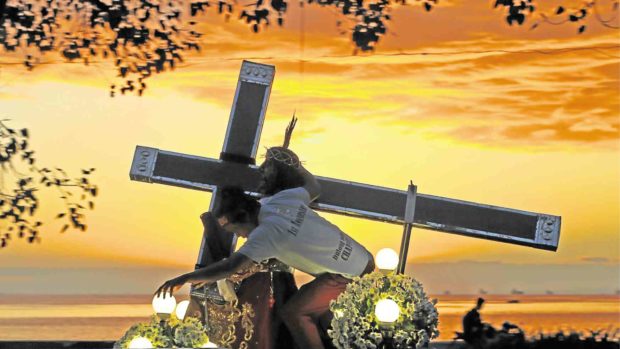
NOT BY TOUCH ALONE Joining the procession should be more than enough proof of one’s devotion to the Black Nazarene, says Fr. Douglas Badong, Quiapo Church parochial vicar. —EDWIN BACASMAS
Devotees of the Black Nazarene need not touch the image to be blessed.
“Even from a distance you could pray [and] talk to Him. But look at Him with deep faith,” Fr. Douglas Badong, parochial vicar of the Minor Basilica of the Black Nazarene or Quiapo Church, told reporters on Tuesday.
According to him, those who intend to participate in today’s “traslacion” need not touch the image or the rope attached to the carriage bearing the life-sized statue of the Black Nazarene.
Many devotees believe that by doing so, their wishes would be granted.
However, their attempts to approach the carriage or hold the ropes slow down the pace of the 6.1-km procession from Quirino Grandstand to Quiapo Church. Last year, the traslacion lasted 22 hours.
“But it’s not about touching the image. The objective of a devotee is to join the procession. And simply joining the procession would be more than enough to profess one’s faith,” Badong said.
Reminder to devotees
He reminded devotees that the Black Nazarene could be visited anytime at the church.
“It is not prohibited to touch it. But it creates problems if everyone wants to touch it during the procession on Jan. 9,” he added.
The annual procession will begin around 5 a.m. today at Quirino Grandstand in Rizal Park.
It will be preceded by the midnight mass to be led by Manila Archbishop Cardinal Luis Antonio Tagle and the 4 a.m. prayer.
Police officials have enforced various security measures, including banning caps, backpacks and nontransparent water jugs, in order to keep disturbances to a minimum.
9,000 police, soldiers
The National Capital Region Police Office said it would be deploying over 7,000 police officers along the procession route. They would be backed up by around 2,000 soldiers.
On Tuesday morning, around 20,000 people gathered at the grandstand for the start of the traditional “pahalik.”
Roger Ballete, a 63-year-old carpenter from Samar, said he had to wait in line for several hours before he was able to touch the image of the Black Nazarene.
He told the Inquirer that he had been joining the pahalik for years to thank God.
Biggest blessing
“The biggest blessing I received was the gift of healing for my daughter who was diagnosed with cancer in 2010. She was cured and I considered it a miracle,” he said.
Another devotee, Felicia Garcia, 55, said she was not only asking for blessings for herself and her family, adding, “I’m also praying for our leaders and for peace and order in our country.” —With reports from Mariejo S. Ramos, Matthew Reysio-Cruz and Jaymee T. Gamil

